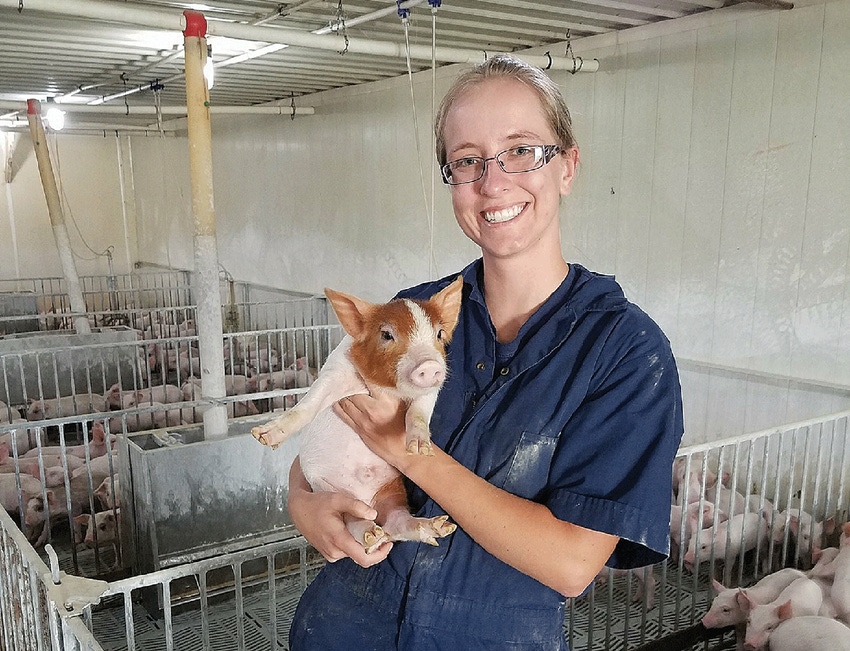Truck wash investigation leads to Morrison Swine Innovator Prize
The first area of the truck Bloemer noticed wash personnel weren’t giving full attention to was the interior of the cab.

With 1 million pigs hitting U.S. roadways daily, pig transport biosecurity is critical for bioexclusion and biocontainment. This is especially important with foreign animal diseases, such as African swine fever that’s inching closer. It’s also one reason University of Illinois veterinary student Megan Bloemer decided to jump in the truck cab and investigate further.
“I didn’t know a lot about how truck washes worked, and the amount of moving parts required prior to this project,” Bloemer says. “What was most interesting for me was the amount of hard work that goes into cleaning these trailers every day and just how critical they are for protecting herd health.”
For improving pig transport bio-security, Bloemer, a third-year veterinary student, was honored at the 2018 Allen D. Leman Swine Conference in St. Paul, Minn. She was the first recipient of the Morrison Swine Innovator Prize, which honors the legacy of the late-Bob Morrison, DVM, who coordinated the conference for many years.
Bloemer’s presentation, “Protecting the Inevitable Risk: Biosecurity Evaluation at a Truck Wash,” helped her rise to the top among the seven student finalists for the award. In addition to covering Leman conference registration and travel costs, she received a cash award of $7,500.
Pigs pique interest
The Bloomington, Ill., native didn’t grow up on a farm. It was through FFA that Bloemer became passionate about agriculture and veterinary medicine. After graduation, she decided to pursue those interests at the University of Illinois, taking a beef cattle internship and joining the 4-H House Cooperative Sorority.
But it wasn’t until she took a research internship between her junior and senior year with Carthage Innovative Swine Solutions that Bloemer found her calling in the swine industry. Since then, she’s had the opportunity to intern at Carthage Veterinary Services another time, as well as at Pipestone Veterinary Services and Iowa Select Farms.
“I really enjoyed the people I got to work with,” Bloemer says. “It was really interesting to see all the records that are kept on each individual animal, and I thought it was amazing how much you can improve the genetic lines with just that information. The herd health aspect was really intriguing to me at that time, too.”
In January 2018, Iowa Select Farms completed a major overhaul of its truck wash procedures. When Bloemer joined its intern program last summer, she was tasked with performing a second-level investigation into its transport biosecurity efforts.
“The truck wash crew and trailer washers are often overlooked, but play such a critical role in disease prevention,” Bloemer says.
Hot spots at the truck wash
For three days, Bloemer followed monitors and spent time with the wash crew and managers to better understand the flow of trucks, people and equipment at the truck wash, which cleaned trailers that were either positive or negative for porcine reproductive and respiratory syndrome.
This led her to her first objective for her study — identifying potential areas of concern.
The first area of the truck Bloemer noticed wash personnel weren’t giving full attention to was the interior of the cab. While the floor and pedals were cleaned very well, the steering wheel, dash, handles, climate control buttons and radio weren’t detailed as much, despite being critical areas that the driver touched each time in the cab. However, Bloemer says it’s areas like these that are difficult for monitors to tell if they have been cleaned or not by visual inspection alone.
Bloemer also examined the movement of rattle paddles, raz cans, boots, sort boards, aluminum bifold panels, electric prods and coveralls in the truck wash. She determined electric prods were the main biosecurity concern as she found some of the truckers placing them in personal vehicles or not cleaning them as efficiently.
“All other equipment stays in the dryers, or has a designated equipment shed and thus is not an issue,” Bloemer says. “Truck wash managers were also frustrated with hot shots not returning.”
With a rechargeable hot handle and prod running around $110 each, Bloemer says the electric prods were also a monetary concern at the truck wash facility. Bloemer decided to investigate the issue further. Where were they going? Were they being cleaned in between loads if they weren’t brought back to the truck wash? Did the prods move from the positive equipment shed to the negative equipment shed?
“This is a large issue if the hot shot is used for a cull load and then a gilt load without being cleaned,” Bloemer says.
She also thought monitor movement may be an issue at the truck wash. Although monitors changed their boots and put on Tyvek before inspecting negative trailers, there was no true “clean-dirty line” where they change shoes. Could these monitors be contaminating negative trailers when they inspect them after inspecting a positive trailer?
The truck wash detective
The second part of Bloemer’s study involved evaluating areas of concern. Using Glo Germ, an odorless lotion or powder that glows brightly when exposed to ultraviolet light, Bloemer went into the cabs of 10 trucks and trailers, and sprayed the steering wheel, dash, door handle, climate handle buttons and radio control buttons after they were cleaned.
She didn’t tell any of the crew, managers or monitors what she was doing. At night, she returned to see what the results might be.
“It worked really well because I was able to actually coat the inside of the cabs with the Glo Germ product, and I was able to go back in at night, and it fluoresces if it wasn’t cleaned off,” Bloemer says. “It was a good way to give monitors the ability there to do internal audits and see if they truly were cleaning. This gives them an additional tool to really measure that.”
Bloemer also went in and numbered all the hot shot handles and prods. Again, at night, she returned to the truck wash for five straight days, checking where each hot shot and prod were, and numbering new ones as they came in.
At the start of one week, there were 14 numbered hot shot handles and 89 numbered prods. By the end of the week, there were 19 handles and 108 prods.
“Over the course of the week, no hot shot handles or prods went from the positive to negative equipment shed,” Bloemer says. “Hot shots and prods were not returning every day, but it is difficult to say if they were being cleaned or not if they didn’t return.”
Staff changes routine
This evaluation made an impact at the truck wash, Bloemer says. More hot shots returned due to the managers putting out a notice to the crew that they would start to record the trucks that didn’t return with hot shots, and the drivers taking notice of the numbered hot shots.
Finally, Bloemer evaluated monitor movement by applying Glo Germ gel and powder to positive trailers before the monitors inspected them and to their shoes before they inspected positive trailers. Each evening she would come back with a UV light to check the negative wash office, negative wash bays, negative trailers that had been washed in the negative wash bay and negative-to-positive trailers that had been washed in the negative wash bay.
In the two days she applied the Glo Germ to the trailers and three days she applied it to the monitors’ boots, Bloemer says she didn’t’ find any evidence of it in any of the four areas.
“Although I didn’t find any Glo Germ in the negative areas, I am still concerned that this may be a potential risk, and I feel that further evaluation should be done,” Bloemer says.
Time, money well spent
Following the evaluation, Bloemer shared with the crew her Glo Germ photos, clarified current protocol and emphasized the importance of cab cleaning. She suggested the truck wash conduct random weekly internal audits of the cab cleaning with Glo Germ.
“This gives the monitors a better way to confirm if the cabs were truly cleaned, other than just visually assessing them,” Bloemer says.
For equipment movement, she suggested again using Glo Germ to check hot shot handles and prods for cleanliness and monitoring which hot shots don’t get returned.
“If we talk about the importance of returning hot shots, it gets attention,” Bloemer says. “It’s like the saying goes, ‘The squeaky wheel gets the grease.’ ”
Bloemer says she hopes the crew at the truck wash found her recommendations easy to add to their regimen. After all, the minor additions in time and cost could prevent a million-dollar-plus PRRS outbreak.
“You can’t have good production, if you don’t have good biosecurity,” Bloemer says. “That goes hand in hand, and you need to think about biosecurity along with your production and how they impact each other.”
Bloemer says the case study also allowed her to see how hard the truck washers work and the value they provide to the swine industry.
“One general comment that I took away from it and really appreciated was how much work it is to actually clean out those trailers at the truck washes,” Bloemer says. “I definitely have a better appreciation for all the work that goes into those trailers and the workers who work on them.”
About the Author(s)
You May Also Like





